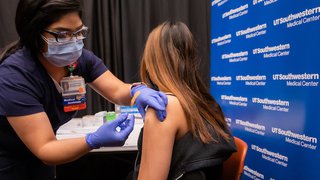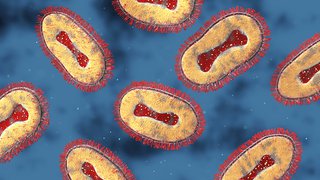More kids are being hospitalized with COVID-19 daily. As parents, we can do better.
September 10, 2021

During the first few weeks of August, as students nationwide returned to in-person learning, more than 500,000 children tested positive for COVID-19. In Texas alone, 31,800 cases were self-reported in schools during the week of Aug. 29 – tripling the number from a week earlier. Pediatric ICUs in Dallas-Fort Worth have been running at or near capacity since mid-August and pediatric hospitalizations set a record over Labor Day weekend with 131 patients, making it a struggle to find space for our sickest kids. Entire pediatric hospitals in DFW have been running dangerously full.
Yet, it seems as if large portions of the public have grown numb to the skyrocketing numbers, unwilling to do even the simplest things – like wearing a mask – to protect our kids from the highly contagious Delta variant.
As a pediatrician who specializes in hospital medicine at UT Southwestern, I have been caring for COVID-19 patients at our partner hospital Children’s Medical Center Dallas since March 2020, and I’ve never felt as frustrated and alarmed as I do right now.
Every day, I look into the eyes of teenagers gasping for breath and young children admitted with sky-high fevers and dehydration, and I can’t help thinking: “This could be my kid.” My 7-year-old daughter and 5-year-old son are both currently too young to get vaccinated.
I’ve also watched heroic colleagues walk away from the profession they love because they felt defeated and burned out by the unrelenting stress the virus has put on our collective health care system.
I’ve seen too many parents with that pained look on their faces when they realize they could have protected their child by getting them vaccinated or getting vaccinated themselves. It’s heartbreaking.
A pandemic of emotions
The scientific part of this pandemic is relatively simple. The virus will continue to multiply and mutate as long as we let it. That’s what viruses do.
The emotional aspects of the pandemic are much tougher. Everyone is tired of living this way. We’re frustrated, tired, angry, and mentally exhausted. But here’s where the pandemic gets personal for me as a doctor and a mother who worries about her children every day at school.
Until vaccines are available to children under 12, which could hopefully be by the end of the year, I must rely on others to help protect my children while they’re in school, and I just don’t understand why some parents are resisting safety measures that will benefit all of our kids.
Like so many parents, my husband and I struggled with the decision of whether to send our children back to school in person this year. In fact, we were debating it right up to the morning school started because masking policies were changing constantly.
Ultimately, we decided since they have no underlying medical conditions they would benefit most from in-person learning, but I have to admit I’ve been dismayed by my daughter’s weekly reports of how fewer and fewer of her classmates are wearing masks. “Well, Mommy,” she said. “Not everyone thinks it’s as serious as you do.”
That’s hard to hear, because while statistically most younger children won’t die from COVID-19, hospitalizations are rising rapidly and the children we’re seeing are sicker and staying in the hospital longer than ever before during the pandemic.
'If people who are resistant to mask wearing and getting vaccinated could see what I see every day – a hospital full of children in pain, some struggling to breathe; exhausted health care workers; parents stricken with fear and guilt – I believe most of them would change their behaviors.'
At Children’s Medical Center Dallas, I’ve seen kids develop diabetes as COVID-19 causes inflammation of the pancreas, seizures from encephalitis because COVID-19 causes inflammation of the brain, and carditis when COVID-19 causes inflammation of their heart.
My concern doesn’t end when a child recovers from COVID-19.
We have seen a new illness emerge in the last 18 months that has been named MIS-C (Multisystem Inflammatory Syndrome in Children), in which a child experiences fever and widespread inflammation of the body that can involve the heart, lungs, kidneys, brain, intestines, and other organs. It usually occurs a couple of weeks after a child has had COVID-19. Symptoms are often so severe, it can be life-threatening without appropriate medical care and commonly requires ICU-level of support.
Like adults, kids can also suffer from long-haul COVID. Symptoms include fatigue, body aches, and brain fog, which can affect their academic performance and overall well-being.
So, I find it frustrating when people focus solely on mortality numbers. As parents, the measuring stick shouldn’t just be: “Is my child going to die?” Rather, I would hope it would be: “What can I do to keep my child safe?”
The best way to do that is:
Vaccinate anyone 12 or older
More than 360 million doses of the COVID-19 vaccines have been administered in the U.S., and overwhelming data have shown they are safe, effective, and the best way to protect yourself and others from serious illness, hospitalization, and death. Vaccines are also readily available at retail pharmacies, your doctor's office, and many other convenient locations. You can also register for a vaccine appointment at UT Southwestern online.
Encourage universal masking at school
I strongly encourage all students, teachers, and staff to wear a covering over their nose and mouth in school to reduce the spread of COVID-19. This is particularly important in elementary schools, where students under 12 are not yet eligible for vaccination. According to large-scale, real-world studies, universal masking has been shown to be an effective tool in reducing the spread of the virus. The American Academy of Pediatric has confirmed that masks do not affect a child’s oxygen levels or their ability to focus in the classroom.

Cohort children as much as possible
Avoid sending them to multiple classrooms with different students to limit their exposure. We used this mitigation strategy successfully during the last school year, but it has been largely abandoned this year even though the Delta variant’s viral load is about 1,000 times more contagious than the original SARS-CoV-2 virus.
Continue to emphasize good hand hygiene
Young children spread germs easily by putting their hands in their mouths (and eyes and noses!). Regularly washing hands and using hand sanitizer in school is simple and it will help limit the spread of COVID-19 and other viruses, which will help keep kids in school and out of the hospital.
Encourage outside activities as much as possible
Being outside is a great way for kids to get exercise and enjoy nature. We have seen that places with poor ventilation contribute to the spread of the virus and there is no better ventilation than fresh air.
Physical distance, particularly at lunch and snack times
Kids have to take off their masks while eating and drinking, so we should encourage creating space between them in the cafeteria and in the classroom during snack time. When the weather cools off a bit, schools should consider letting students eat outside, which would help reduce potential transmission as well.
I know most people have grown weary of hearing the familiar drumbeat of “get vaccinated, wear a mask, wash your hands, social distance,” but this pandemic is not over – no matter how much we wish it were.
If people who are resistant to mask wearing and getting vaccinated could see what I see every day – a hospital full of children in pain, some struggling to breathe; exhausted health care workers; and parents stricken with fear and guilt – I believe most of them would change their behaviors and then we could finally beat this pandemic.
I have to believe that.
***
Jennifer Johnston, M.D., is an Assistant Professor of Pediatrics at UT Southwestern. She is board-certified in pediatric hospital medicine and treats patients at Children Medical Center in Dallas.











